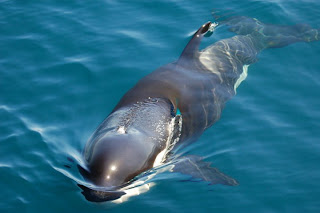For a long time the entertainment value of keeping dolphins in marine parks has been accepted. However as more and more evidence of dolphin 'intelligence' and their complex social dynamics is coming about, the ethics and welfare of dolphins in captivity are being increasingly questioned. Although the majority of marine parks promote the benefits of conservation and education by having marine mammals - enabling the public to observe them up close and interacting with them - studies show that the lives of dolphins are not improved in captivity compared to that of wild dolphins, despite the claim they give these animals the chance to live a better life away from the hardships of their natural environment. As for the public being educated by visiting one of these marine parks, they are observing nothing more than desperate animals performing artificial, conditioned behaviours in order to gain a food reward. While the rescue and rehabilitation of sick and injured animals within these parks deserves commendation, bringing a free ranging wild dolphin into or raising a dolphin in a false environment, that is so much different and smaller in size than their natural environment and lacking the highly complex social dynamics dolphins thrive on, inevitably has a variety of harmful impacts...
Captivity puts a huge amount of stress on dolphins – from the capturing, to the handling, transportation, and confinements of the tanks where they are forced to live with unknown fellow dolphins, who they would not usually come across in the wild. Stress leads to many different harmful effects, in particular health problems, behavioural changes and death. Dolphins experience appetite loss, weight loss, reduction in reproduction, stomach ulcers, a higher susceptibility to disease due to the impact of stress on their immune system, inevitably (and often) resulting in death. The massive difference between a dolphins natural environment and the captive environment contribute greatly to the stress imposed on these animals. Whether they are taken away from their tight knit family group in the wild or bred in captivity, studies highlighting the high mortality rates soon after capture and as a result of captive breeding show us that dolphins do not become used to the constraints of captivity (even when they are bred into that environment in the first place!)
Many behavioural changes are seen in captive dolphins. They can become very antisocial, showing aggression towards fellow dolphins, fighting over dominance within the social group they are forced into, no interest in performing, and a loss of maternal care towards offspring. Furthermore, not only do these animals become aggressive towards other dolphins, but there has also been cases of unexpected behaviours leading to injuries or deaths of trainers – not too long ago an orca trainer was killed in a marine park, and she is not the only one to tragically die this way. Whilst aggression and conflict over dominance does occur in the wild, it is not bought about by forced, artificial social groupings that occur in captivity, and there is always the option to escape in the wild. Many natural behaviours, including foraging, mating and maternal interactions with calves, are restricted in captivity and controlled by the parks – the dolphins needs are put behind the running of the park and the space that is available. As a result, these potential highly intelligent animals become bored of the confinements of their tanks and the monotonous routine of performing many times a day in return for some food. The constant stimulation dolphins find in the wild, from travelling vast areas of ocean, to chasing down prey and the playful, social interactions within the family groups, is taken away from them in captivity. Although they may seem to be 'enjoying' the leaps, jumps and interactions when performing, you have to remember these are not natural, stimulating behaviours, these dolphins are performing for food.....food they have sometimes been deprived of in order to ensure a good show, it has been revealed by ex-trainers!
So as for marine parks being a place of conservation and education, I couldn't disagree more. Not only do they reduce the quality of life, as well as the longevity of these dolphins, the public are not learning anything about the real life of a dolphin. A proper education requires people to go and see them in their natural environment, experiencing them playing and interacting with their wild surrounding and real family groups. Not only does it make you realise the confinements of captivity, but just how false an environment it is for these free-ranging, highly sociable animals.
As part of the evaluation of my Final Year Project I would appreciate if you could take a few minutes to answer the following short questionnaire regarding my blog. Thank you!!

